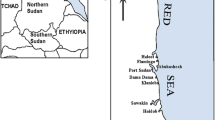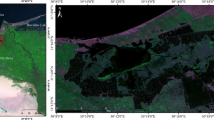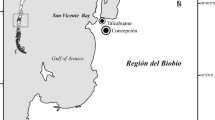Abstract
Microalgae are rich source of protein containing necessary amino acids at different levels. The present study was designed to assess stimulatory and/or inhibitory impact of five different concentrations (5, 10, 15, 20, and 25 mg/L) of three essential heavy metals (nickel, zinc, and copper) on protein content (soluble, insoluble, and total) of the marine unicellular green alga Dunaliella tertiolecta. Further, geospatial analyses were used to assess the suitability of Qaroun Lake for D. tertiolecta proliferation. The experimental results showed a gradual increase in protein content of D. tertiolecta with low concentrations of the three investigated heavy metals. However, increasing levels of heavy metals led to inhibitory effect on protein synthesis in alga with different grades. Ni, Zn and Cu levels in Qaroun lake were found suitable for the proliferation of Dunaliella (Lower than 5 mg/L). The present study highly recommends the necessity to encourage site selection of optimal marine environments suitable for the proliferation of marine algae rich in protein content.






Similar content being viewed by others
Data availability
The authors declare that all relevant data are included in the article.
References
Abalad, J., Cid, A., Herrero, C., & Torres, E. (1995). Response of the marine micro-alga Dunaliella tertiolecta to copper toxicity in short time experiments. Bulletin of environmental contamination and toxicology, 54(317).
Abd El-Aal R. F., El Sayed S. M., Attia M. S., Donia N. S., & Goher M. E. (2020). Pollution indices and distribution pattern of heavy metals in Qarun Lake water, Egypt. Egyptian Journal of Aquatic Biology & Fisheries, 24(1), 593–607.
Ajay, A., & Subrahmanyam, D. (1996). Heavy metals induce changes in chlorophyll pattern in tomato and Chlorella pyrenoidosa. Ann. of Plant Physiology, 10(1), 17.
Arunakumara, K. K. I. U., & Zhang, X. (2008). Heavy metal bioaccumulation and toxicity with special reference to microalgae. Journal of Ocean University of China, 7(1), 60–64.
Cossich, E. S., Tavares, C. R. G., & Ravagnani, T. M. K. (2002). Biosorption of chromium (III) by Sargassum sp. biomass. EJB Electronic Journal of Biotechnology, 5(2): 133–140.
Dezhong, S., Hongkong, W., & Ying, L. (1995). Effect of heavy metals on quantity and types of soil algae in Paddy field. Acta Agriculturae Universitatis Pekinensis, 21(1), 50.
Dhargattar, U. K. (1986). Biochemical Studies in Ulva reticulate Forsskal. Mahassagar Bulletin of the National Institute of Oceanography, 19(1), 4551.
EEAA. (2020). Monitoring program of Egyptian Lakes: Qaroun Lake. Cairo. Periodic Report.http://www.eeaa.gov.eg/portals/0/eeaaReports/water/reportFeb17/%D9%82%D8%A7%D8%B1%D9%88%D9%86.pdf
El-Din, S. (2018). Effect of copper and lead on growth and some metabolic activities of Cyanobacterium Spirulina platensis (Nordstedt). Egyptian Journal of Botany, 3(57), 445–456.
El-Mazally, E. E. (2002). Ecophysiological studies on the phytoplankton communities of River Nile at Kafr El-Zayat city with relevance to pollution with industrial effluents. Ph.D. Thesis Botani Departmert Faculty of Science, Tanta University.
El-Zeiny, A. M., El Kafrawy, S. B., & Ahmed, M. H. (2019). Geomatics based approach for assessing Qaroun Lake pollution. The Egyptian Journal of Remote Sensing and Space Sciences, 22(3), 279–296.
Engel, D. W., Sunda, W. G. & Fowler, B. A. (1981). Factors affecting trace metals uptake and toxicity to estuarine organisms. In F. J. Vernberg, A. Calabress, F. P. Thurberg & W. B. Vernberg (Eds.), 1-Environmental parameters in Biological Monitoring of Marine Pollutants. (p. 127). Academic Press, New York
Exss-Sonne, P., Tölle, J., Bader, K. P., Pistorius, E. K., & Michel, K. P. (2000). The Idil A protein of Synechococcus sp. PCC7942 functions in protecting the acceptor side of photosystem II under oxidative stress. Photosynthesis Research, 63, 145–157.
Fukami, M., Ohbayashi, H., Yoshimura, E., & Shozo, T. (1988). Effects of zinc on metal metabolism on the zinc tolerant chlorotic mutants of Euglena gracilis. Z. Agric Biol Chem., 52(9), 2343–2344.
Gabryś, H., Kacperska, A., Kopcewicz, J., Lewak, S., Starck, Z., Strzałka, K. & Tretyn, A. (2005). Plant physiology (In Polish) Kopcewiczi Lewaka [ed.], PWN Publishing House, Warsaw.
Gaetke, M., & Chow, C. K. (2003). Copper toxicity, oxidative stress and antioxidant nutrients. Toxicology, 189, 147–163.
Godfray, H. C., Beddington, J. R., Crute, I. R., Haddad, L., Lawrence, D., Muir, J. F., Pretty, J., Robinson, S., Thomas, S. M., Toulmin, C. (2010). Food security: The challenge of feeding 9 billion people, 12; 327(5967):812–8.
Gouveia, L., Batista, A. P., Sousa, I., Raymundo, A., & Bandarra, N. (2008). Microalgae in Novel Food Products (pp. 75–112). Food Chemistry Research Development. Nova Science Publishers; New York.
Hartree, E. F. (1972). A modification of Lowry method that gives a linear photometric response. Analyt. Biochem., 48, 422.
Holman, B. W., & Malau-Aduli, A. E. (2013). Spirulina as a livestock supplement and animal feed. Journal of animal physiology and animal nutrition (Berl), 97(4):615–23.
Jeyachandran, R., & George, V. K. (1991). Zinc toxicity and its alleviation by calcium salts in alga Scenedesmus acutus. Journal of Ecotoxicology and Environmental Monitoring, 1(3), 180.
Kaamoush, M., & El-Agwany, N. (2021). Comparison between the toxicity of Copper and Irgarol 1051 as two different generations of antifoulings on growth and essential metabolites of marine algae (Dunaliella salina as a case study). Egyptian Journal of Aquatic Biology and Fisheries, 25(2): 487 – 508 .
Kondzior P., & Butarewicz A. (2018). Effect of heavy metals (Cu and Zn) on the content of photosynthetic pigments in the cells of algae Chlorella vulgaris. Journal of Ecological Engineering, 19(3), 18–28.
Lam, P. K. S., Wut, P. F., & Wu, R. S. S. (1999). Individual and combined effects of cadmium and copper on the growth response of Chlorella vulgaris. Environmental Toxicology, 14, 347.
Loeblich, L. A. (1982). Photosynthesis and pigments influenced by light intensity and salinity in the halophilic Dunaliella salina (Chlorophyta). J. Mar. Biol. Ass. UK, 62, 493–508.
Lowry, O. M., Rosebrough, N. J., Farr, L. A., & Randall, R. J. (1951). Protein measurements with folin phenol reagent. Journal of Biological Chemistry, 193, 265–275.
Mark, L. W., Philippe, P., James, S. C., John, A. R., Sabeeha, S. M., Katherine, E. H., Alison, G. S., Mary, E. C., & Susan, H. B. (2017). Algae as nutritional and functional food sources: Revisiting our understanding. Journal of Applied Phycology, 29, 949–982.
Mofeed, J. (2017). Biosorption of heavy metals from aqueous industrial effluent by non-living biomass of two marine green algae Ulva lactuca and Dunaliella salina as Biosorpents. CATRINA, 16(1), 43–52.
Moussa, I. D., Athmouni, K., Chtourou, H., Ayadi, H., Sayadi, S., & Dhouib, A. (2017). Phycoremediation potential, physiological, and biochemical response of Amphora subtropica and Dunaliella sp. to nickel pollution. J. of App. Hycol;., 30, 931–941.
Nassar, M. Z. (2000). Ecophysiological studies on phytoplankton along the western coast of Suez Gulf. Ph.D. Thesis Facuty of Science in Botani Department, Tanta University.
Rauch, T. (1981). The estimation of microalgal protein content and its meaning to the evolution of algal biomass. I., Comparison method for extracting protein. Hydrobiologia; 78: 237.
Shafik, M. A. (2008). Phytoremediation of some heavy metals by Dunaliella salina. Global Journal of Environ Research, 2(1), 1–11.
Shahidul, I., & Masaru, T. (2004). Impacts of pollution on coastal and marine ecosystems including coastal and marine fisheries and approach for management. Marine Pollution Bulletin, 46, 624–649.
Stein, J. R. (1979). Hand book of phycological methods. Cambridge University Press, London.
Stephen, B., & Maria, H. (2017). Algal proteins: Extraction, application, and challenges concerning production. Foods, 6(5), 33.
Strivens, J., Hayman, N., Rosen, G., & Myers-Pigg, A. (2020). Toward validation of toxicological interpretation of diffusive gradients in thin films in marine waters impacted by copper. Environmental Toxicology and Chemistry, 39, 873–881.
Sui, Y,. & Vlaeminck S. E. (2020). Dunaliella Microalgae for Nutritional Protein: An Undervalued Asset. Trends in Biotechnology, 38(1), 10–12
Thomas, P., & Dumas, R. (1970). Contribution a L’etude de Dunaliella salina culture bacterienes: Nutrition et composition. Tethys, 2, 19–28.
Tokuşoglu, Ö., & Üunal, M. (2003). Biomass nutrient profiles of three microalgae: Spirulina platensis, Chlorella vulgaris, and Isochrisis galbana. Journal of Food Science, 68:1144–1148.
Travieso, L., Pellón, A., Benitez, F., Sánchez, E., Borja, R., Farrill, N. O., & Wwiland, P. (2002). Bioalga reactor: Preliminary studies for heavy metals removal. Biochemical Engineering Journal, 12, 87–91.
Wang, T. C., Weissmann, J. S., Ramesh, G., Varadarajan, R., & Benemann, J. R. (1995). Bioremediation of Inorganics; United States: 33.
Wong, M. H., & Pak, D. C. H. (1992). Removal of copper and nickel by free and immobilized microalgae. Biomedical and Environmental Sciences, 5, 99–108.
Xylaender, M., & Braune, W. (1994). Influence of nickel on the green alga Haematococcus lacustris rostafinski in phases of its life cycle. Journal of Plant Physiology, 144(1), 86–93.
Author information
Authors and Affiliations
Corresponding author
Additional information
Publisher's Note
Springer Nature remains neutral with regard to jurisdictional claims in published maps and institutional affiliations.
Rights and permissions
About this article
Cite this article
El Agawany, N., Kaamoush, M., El-Zeiny, A. et al. Effect of heavy metals on protein content of marine unicellular green alga Dunaliella tertiolecta. Environ Monit Assess 193, 584 (2021). https://doi.org/10.1007/s10661-021-09353-y
Received:
Accepted:
Published:
DOI: https://doi.org/10.1007/s10661-021-09353-y




